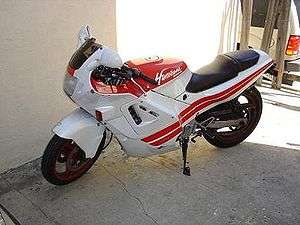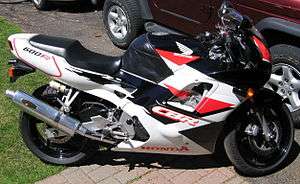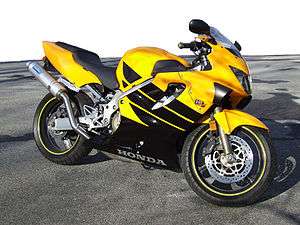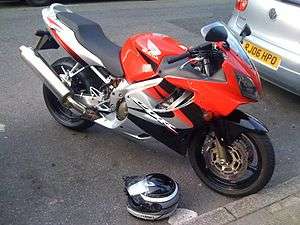Honda CBR600F
 | |
| Manufacturer | Honda |
|---|---|
| Also called | Hurricane |
| Production | 1987–1990 |
| Predecessor | VF500F |
| Successor | CBR600F2 |
| Class | Sport bike |
| Related | Honda CBR600RR |
The Honda CBR600F, known as the 'Hurricane' in the US market, is a sports motorcycle made by Honda from 1987 to 1990. In Austria and Mexico, a smaller version, the CBR500F, was marketed. In 2011, Honda released an all-new model of the same name.[1][2] The original CBR600F along with the CBR750F and CBR1000F was Honda's first inline four-cylinder, fully faired sport bike. It had a liquid-cooled 85 hp (63 kW) DOHC 16-valve engine, and a six-speed transmission and an ignition with CDI, 2 coils. The Honda Hurricane was introduced as the newest style of sport bike.
 | |
| Also called | PC25 |
|---|---|
| Production | 1991–1994 |
| Predecessor | CBR600F |
| Successor | CBR600F3 |
| Class | Sport bike |
Successors
CBR600F2
The Honda CBR600 F2 was made from 1991 to 1994. It was introduced to replace the CBR600 Hurricane, or F1, and was considered one of Honda's most modern and innovative sport bikes. Development of the second generation CBR began in early 1989. Hurricane LPL Ishikawa led the development of the new bike, known internally as MV9 but also called the F2, an alphanumeric that led to its official name: CBR600F2.
The F2's development began with meetings to discuss concepts and sketches for the new bike. A few months later, an F2 prototype was produced. Painted black, the bike looked faster and sleeker than the more blocky first generation bike, and test results were superior: few motorcycles in the 1990s had the performance ability of the F2.[3]
CBR600F3
 | |
| Production | 1995–1998 |
|---|---|
| Predecessor | CBR600F2 |
| Successor | CBR600F4 |
| Class | Sport bike |
The CBR600F3 is the third generation of the CBR600F series. It replaced the F2, and was produced from 1995 to 1998. It had a modified engine, ram-air intake and cartridge forks. The 1997 and 1998 models also came with a deeper oil pan, sleeker tail fairings, seat and tail light, and a revised engine head netting about a 5 hp gain over 95/96 models. The CDI and ram-air system were also revised to allowed for smoother throttle curve over the 95/96 models, which could sometimes be jerky. The last made 1998 models came with another revised engine head which resulted in a slight power gain. In 1999, it was replaced by the CBR600 F4.
In 1996 and 1998 the CBR600F3 was also sold in "Smokin' Joe's Replica" versions in the USA, Canada and Australia (1998 only).
Cycle World tested the F3's acceleration from 0 to 60 miles per hour (0 to 97 km/h) at 3 seconds and 0 to 1⁄4 mile (0.00 to 0.40 km) at 10.9 seconds at 125.28 mph (201.62 km/h).[4] Motorcycle Consumer News recorded a 0 to 60 mph time of 3.7 seconds and a 1⁄4 mile time of 11.03 seconds at 124.06 mph (199.66 km/h)[5]
CBR600F4
 | |
| Production | 1999–2000 |
|---|---|
| Predecessor | CBR600F3 |
| Successor | CBR600F4i |
| Class | Sport bike |
The Honda CBR600F4 was produced between 1999 and 2000. It is the last of the CBR600 series of Honda sportbikes to be carbureted. An aluminium twin spar frame which reduced frame weight was used, and the engine crankcase was designed to share swing-arm pivot. Through a reduction of internal friction and weight, combined with larger valves, shorter stroke, and a bigger bore, higher revs were enabled. The spark plug caps had Ignition coils built into them. Slightly larger carbs were added and the oil cooler was now located by the oil filter. A new suspension had larger 43 mm forks and used Fireblade parts. The front brakes were upgraded, and the rear rim increased to 5.5” with new 3-spoke wheels. The F4 was fitted with Honda’s HISS engine immobiliser system.
The phrase "Dedicated to Super Evaluators Dirk Vandenberg and Josef Boyd" are embossed in raised letters on the inside of the Honda CBR600F4's upper fairing;[6] the dedication is to two of Honda R&D's senior product developers who were killed during the final testing of this model.
CBR600F4i
 | |
| Production | 2001–2006 |
|---|---|
| Predecessor | CBR600F4 |
| Successor | Honda CBR600F (2011) |
| Class | Sport bike[7] |
| Related | Honda CBR600RR |
The Honda CBR600F4i is a sport bike[7] that was produced by Honda from 2001 to 2006. Two UK versions of the F4i were released in 2001. The CBR600F F1 and onwards had the banana style seat found on pre PGM FI bikes whilst the CBR600F FS1/FS2 (the F sport) were sold with the two tier seat units, black frames and various other performance upgrades as found in the US model CBR600F4I. The F sport was discontinued upon the arrival of the CBR600RR in 2003. In 2003, Honda introduced the CBR600RR, as a higher-performance race-ready, race replica alternative to Honda's more street oriented 600-class sport bike, the CBR600F4i.[8] In 2004, the one-piece "banana" seat model replaced the split seat model. This bike sacrificed a little performance but gained a more comfortable riding position with the one piece seat, in addition to the clip-ons mounted above the top fork clamp already and also replacing the black frame with one in silver.[9][10] As well as an engine configuration better suited to everyday riding. This model is the same as the CBR600F1 and onwards that was sold in the UK from 2001.The F4i remained available for three more years before being discontinued, with the 2006 model being the final one to be released. No major updates were made in these final years except for color scheme changes.
History
For the 2001 model year Honda released an upgraded version of the popular CBR600F4 with intentions of becoming more competitive in the middleweight sport bike class. The 370 lb (170 kg) (dry) F4i is a modified F4 with numerous engine, chassis and bodywork changes.
The 2001 US F4i had a new subframe which raises the seat by five millimeters allows for more storage room and improved two-tier seat.[11] The new tail unit has less padding and a higher perch for the passenger. The F4i's tail-light is smaller with a new dual-bulb configuration. The F4i had a new dash layout with a large analog tachometer. The new LCD digital display had a speedometer, odometer, clock, engine temperature read-out, amber shift light, and trip meters.The single largest change aside from the styling is the addition of high-pressure (50 psi).[12] programmed fuel injection — thus the model designation "F4i". In a number of countries, the bike was sold in both the "normal" and "Sport" variants, the Sport having a two-part seat, no grab rail and no main stand (though the main stand mounting holes remained). Fuel injection allows for more precise fuel metering and delivery over a wider rpm range, while providing better throttle response and reducing emissions. The injectors reside one per cylinder and work with 38 mm throttle bodies. Each injector has four nozzles, and together the injectors add up to five horsepower over the F4.
Weight was also reduced. The rear wheel was made lighter, and the front wheel.[9] The rotor carriers moved out closer to the brake calipers to reduce weight and to improve rigidity. But stopping power still was not on par with other bikes in the class. There is additional bracing on the steering head for more response, better feedback and feel from the front end. The suspension has also been tweaked with less high-speed damping and a little more low-speed damping with the shock and fork being more street-bias.[13]
 | |
| Manufacturer | Honda |
|---|---|
| Production | 2011-2013 |
| Predecessor | Honda CBR600F4i |
| Successor | Honda CBR650F |
| Class | Sport bike |
| Related | Honda CB600F |
Additional engine changes include a lighter camshaft sprocket and increased valve spring pressure (two springs per intake valve) which allow for higher revving. There are new piston rings that slide with less friction and increased internal engine oil flow. Redline is now 14,200 rpm,[9] 700 rpm higher than the previous year's F4.[14] To increase the bike's pulling capabilities at high speeds, 5th and 6th gears have been shortened slightly and the rear sprocket was enlarged from 45 teeth to 46.Also adding one clutch plate for greater durability to now making 8.[14] The oiling holes in the camshafts have been enlarged by 0.5 mm (to 2.5 mm) and piston ring friction has been decreased to aid cooling at the higher rev ceiling.[14] Spring pressures on the intake and exhaust valves have been increased to avoid valve float. Also, there are now two valve springs (inner and outer) on the intake side instead of the single item that resides on the exhaust side.[15]
The F4i's new bodywork carries a more racy look and provides a 3% reduction in drag. It also houses a new dual headlight front cowl design which uses 40% brighter H7 bulbs compared to the old H4 bulbs.[14] The headlights are dual multi-reflector units covered by a one-piece flexiglass lens. The turn stalks are shorter and the mirrors are now positioned higher and closer to the rider. The elimination of carburetors allowed for a slightly larger air box and a larger 4.8 US gal (18 l; 4.0 imp gal) fuel tank. And a fuel consumption of 36.7 mpg-US (6.41 L/100 km; 44.1 mpg-imp).[16]
In 2001 and 2002, in recognition of Honda's association with MotoGP champion Valentino Rossi, and its 500th motorcycle Grand Prix victory, the CBR600F4i was also released in Europe and Australia (2002 only) in two "Rossi Replica" versions.
|
| |
| Manufacturer | Honda |
|---|---|
| Production | 2014-present |
| Predecessor | Honda CBR600F (2011) |
| Class | Sport touring |
| Related | Honda CB650F |
2011 CBR600F
In 2011, Honda released a new CBR600F model built in Italy for the European markets that was not released in America. It continues the legacy of the CBR model F line.[17] To honors the German rider Stefan Bradl Honda Germany launched a special edition of the CBR600F the CBR600F LCR. It featured an Arrow titanium exhaust Progrip handlebar grips, a rear hugger and single seat cover and an LCR sticker kit as well as combined braking and ABS.[18] The CBR600F shares most of the components of the naked CB600F 'Hornet' such as inverted fork though longer by 50mm and aluminium Mono-backbone frame.[19][20] But wraps it in a multi-layered full fairing that lowers drag and protects the rider from windblast as well as new instruments, bars, and tank. It also retains a similar relaxed seating position to minimise rider fatigue.[21] The 2011 CBR600F also shares the engine of the highly revised CB600F model that came out in April 2007. This engine is a detuned version of that which is available in the 2007 CBR600RR giving a maximum output power of approximately 102 bhp (76 kW) at 12,000 rpm and 47.94 lb·ft (65.00 N·m) of torque at 10,500 rpm.
2014 CBR650F
The Honda CBR650F is a sport touring motorcycle, part of the Honda CBR series,[22] manufactured by Honda for their global market. It was released in 2014 alongside its naked sibling, the CB650F.[23] The bike replaces the 2011–2013 CBR600F. It is powered by a liquid-cooled four-stroke 648.7 cc (39.6 cu in), DOHC, 16-valve, inline-four engine.[24] Though bike is new from the ground up, it has 19 years of development.[22] The motor which looks a lot like an early model CBR600RR is aimed at more mid range and low end than the typical 600 cc supersport bikes.[3] It has about the same specs as a F2. And like the F2, it has a steel twin spar frame.[25] With a wet weight much like the F2 as well at 460 lb (210 kg).[3]
Specifications
All specifications are claimed by the manufacturer unless otherwise specified.
| Model | Honda CBR600F | Honda CBR600F2 | Honda CBR600F3 | Honda CBR600F4 | Honda CBR600F4i | Honda CBR600F | Honda CBR650F |
|---|---|---|---|---|---|---|---|
| Years | 1987-1990 | 1991-1994 | 1995-1998 | 1999-2000 | 2001-2006 | 2011-2013[26] | 2014-present |
| Engine displacement | 599 cc (36.6 cu in) | 649 cc (39.6 cu in)[27] | |||||
| Engine type | Inline-4 | ||||||
| Bore | 63.0 mm × 48.0 mm (2.48 in × 1.89 in) | 65.0 mm × 45.2 mm (2.56 in × 1.78 in) | 65.0 mm × 42.5 mm (2.56 in × 1.67 in) | 67.0 mm × 46.0 mm (2.64 in × 1.81 in)[27] | |||
| Stroke | 4 | ||||||
| Compression ratio | 11.0:1 | 11.5:1 | 12:1 | 11.4:1[27] | |||
| Power | 85.8 hp (64.0 kW) @ 11,000 rpm (claimed)[28] | 85 hp (63 kW)(rear wheel)[3] | 90.2 hp (67.3 kW) (rear wheel)[16] | 94.1 hp (70.2 kW) (rear wheel)[16] | 109 hp (81 kW) @ 12,500 rpm (claimed) 90.1 hp (67.2 kW) at rear wheel[16] |
102 hp (76 kW) @ 12,000 rpm (claimed) | 85.8 hp (64.0 kW) @ 11,000 rpm (claimed)[27] 78.7 hp (58.7 kW) @ 10,800 rpm[29] (rear wheel) |
| Torque | 44 lb·ft (60 N·m) @ 8,500 rpm (claimed) | 47.2 lb·ft (64.0 N·m) @ 10,500 rpm (claimed) | 43.0 lb·ft (58.3 N·m) (rear wheel)[16] | 43.6 lb·ft (59.1 N·m) (rear wheel)[16] | 46 lb·ft (62 N·m) @ 10,000 rpm (claimed) | 47.94 lb·ft (65.00 N·m) @ 10,500 rpm (claimed) | 46 lb·ft (63 N·m) @ 8,000 rpm (claimed)[27] 42.8 N·m (31.6 lb·ft) @ 7,900 rpm[29] (rear wheel) |
| Top speed | 130 mph (210 km/h)[3] | 153 mph (246 km/h)[16] | 156 mph (251 km/h)[16] | 155 mph (249 km/h)[16] | |||
| Transmission | six-speed | ||||||
| Tires | Front:110/80-17 Rear: 130/80-17 |
Front:110/80-17 Rear: 130/80-17 |
Front:120/60-17 Rear: 160/60-17 |
Front:120/70-17 Rear: 180/55-17 |
Front:120/70-17 Rear: 180/55-17 |
Front:120/70-17 Rear: 180/55-17 |
Front: 120/70ZR17 radial Rear: 180/55ZR17 radial |
| Frame | Steel twin spar frame | Aluminum twin-spar, box-section | Aluminium Mono-backbone frame | Steel twin spar frame | |||
| Suspension | Front:37 mm (1.5 in) telescopic fork Rear: Pro-Link monoshock with spring-preload |
Front: 41 mm (1.6 in) Rear:Pro-Link monoshock with spring-preload |
Front: 41 mm (1.6 in) HMAS cartridge fork preload and rebound adjustability Rear:Pro-Link HMAS monoshock fully adjustable |
Front: 43 mm (1.7 in) HMAS fully adjustable cartridge-type fork Rear:Pro-Link HMAS monoshock fully adjustable |
Front: 43 mm (1.7 in) HMAS fully adjustable cartridge-type fork Rear:Pro-Link HMAS monoshock fully adjustable |
Front: 41 mm (1.6 in) inverted telescopic fork Rear: monoshock adjustable with spring-preload |
Front: 41 mm (1.6 in) conventional Telescopic fork; 109.2 mm (4.3 in) travel Rear: Single shock with spring-preload adjustability; 127.0 mm (5.0 in) travel |
| Brakes | Front:276 mm (10.9 in) dual disk, 2 piston caliper Rear:218 mm (8.6 in) single disk, 1 piston caliper | Front:276 mm (10.9 in) dual disk, 2 piston caliper Rear:218 mm (8.6 in) single disk, 1 piston caliper | Front:276 mm (10.9 in) dual disk, 2 piston caliper Rear:218 mm (8.6 in) single disk, 1 piston caliper | Front:296 mm (11.7 in) dual disk, 4 piston caliper Rear:220 mm (8.7 in) single disk, 1 piston caliper | Front:296 mm (11.7 in) dual disk, 4 piston caliper Rear:220 mm (8.7 in) single disk, 1 piston caliper | Front:296 mm (11.7 in) dual disk, 2 piston caliper Rear:240 mm (9.4 in) single disk, 1 piston caliper | Front: Two-piston calipers with dual 320 mm (12.6 in) discs Rear: Single-caliper 240 mm (9.4 in) disc |
| Dimensions | length:2,050 mm (80.7 in) width:685 mm (27.0 in) |
length:2,010 mm (79 in) width:695 mm (27.4 in) |
length:2,055 mm (80.9 in) width:685 mm (27.0 in) |
length:2,110 mm (83.1 in) width:755 mm (29.7 in) height:1,145 mm (45.1 in) | |||
| Rake,Trail | 25.2°, 94.0 mm (3.70 in) | 24.0°, 96 mm (3.8 in) | 24.0°, 96 mm (3.8 in) | 25.3°, 101.3 mm (4.0 in) | |||
| Wheelbase | 1,410 mm (55.5 in) | 1,405 mm (55.3 in) | 1,400 mm (55.3 in) | 1,390 mm (54.9 in) | 1,390 mm (55 in) | 1,390 mm (54.9 in) | 1,450 mm (57.1 in)[27] |
| Seat height | 770 mm (30.3 in) | 810 mm (32 in) | 810 mm (32 in) | 810 mm (32 in) | 805 mm (31.7 in) | 805 mm (31.7 in) | 810 mm (31.9 in)[27] |
| Dry weight | 180 kg (397 lb) | 374.8 lb (170.0 kg) | 370 lb (170 kg) | ||||
| Wet weight | 204 kg (450 lb) | 213.18 kg (470.0 lb)[3] | 206 kg (454 lb) (Honda service manual) | 435 lb (197 kg)[16] | 440 lb (200 kg)[16] | 425 lb (193 kg) | 211 kg (465 lb)[11] 210 kg (460 lb)[27][29] |
| Fuel_capacity | 16.5 L (3.6 imp gal; 4.4 US gal) | 16 l (3.5 imp gal; 4.2 US gal) | 17 litres; 3.7 imperial gallons (4.5 US gal) | 4.8 US gallons (18 l; 4.0 imp gal) | 17.3 L (4.6 US gal) | ||
References
- ↑ "2011_CBR600F". honda. Retrieved 2010-11-14.
- ↑ "1987_Hurricane". honda.com. Archived from the original on January 9, 2008. Retrieved 2008-03-06.
- 1 2 3 4 5 6 Ets-Hokin, Gabe (November 21, 2014). "2014 Honda CBR650F: MD Ride Review". Motorcycle Daily. Retrieved July 25, 2016.
- ↑ "Battle of the Superbikes; Ultimate 600 Challenge", Cycle World, p. 36, February 1997
- ↑ "Performance Index Winter '12/'13 Edition" (PDF), Motorcycle Consumer News, Bowtie Magazines, January 2013
- ↑ "F4 Secret Message?!?!". CBR600F4.com. Retrieved 2011-03-17.
- 1 2 "Performance Index '10" (PDF), Motorcycle Consumer News, Bowtie Magazines, 2010, retrieved 2010-01-03
- ↑ Cameron, Kevin (December 2002), "Red Rocks! 2003 Honda CBR600RR", Cycle World, pp. 28–29
- 1 2 3 Smith, Jerry (May 10, 2015). "2001-2006 Honda CBR600F4i - SMART MONEY". Motorcyclist. Retrieved July 22, 2016.
- ↑ "SR's Middleweight Comparison Test - Get Real!". Sport Rider. March 1, 2011. Retrieved July 29, 2016.
- 1 2 Paul, Paul (July 1, 2014). "2014 Honda CBR650F - First Ride". Cycle World. Retrieved July 25, 2016.
- ↑ Demortier, Cyril (May 24, 2007). "2006 Honda CBR600F4i". Top Speed. Retrieved July 27, 2016.
- ↑ Edge, Dirck (April 5, 2001). "2001 Honda CBR600F4i: MD Ride Review". Motorcycle Daily.com. Retrieved July 28, 2016.
- 1 2 3 4 "First Ride: 2001 Honda CBR600F4i". Motorcycle.com. December 20, 2000. Retrieved July 27, 2016.
- ↑ "Honda CBR 600 F4i". MCNEWS.com.au. November 15, 2001. Retrieved July 28, 2016.
- 1 2 3 4 5 6 7 8 9 10 11 "Performance Index '07/'08 Version" (Adobe PDF). Motorcycle Consumer News. January 2008. Retrieved 2010-01-11.
- ↑ Ets-Hokin, Gabe (November 18, 2010). "What You Can't Have: 2011 Honda CBR600F". Motorcycle Daily.com. Retrieved July 28, 2016.
- ↑ Beeler, Jensen (May 26, 2012). "Honda CBR600F LCR Edition – Stefan Bradl's Race Replica". Asphalt & Rubber. Retrieved July 28, 2016.
- ↑ Falconer, Mel (June 17, 2011). "Road Test: 2011 Honda CBR600F ABS and 2004 Honda CBR600F - Sibling rivalry". Motorcycle Monthly. Retrieved July 28, 2016.
- ↑ Keen, James (November 5, 2010). "2011 Honda CBR600F - full tech specs". Motorcycle News.com. Retrieved July 28, 2016.
- ↑ "Honda UK Website". Honda UK. Retrieved 2013-01-10.
- 1 2 West, Phil (June 27, 2014). "First Ride: Honda CBR650F". Motorcyclenews. Retrieved September 9, 2016.
- ↑ "Honda offers even more choice with 13 new or revised models for 2014". Honda WorldWide. Honda. Retrieved 29 May 2016.
- ↑ "Specifications". Honda Powersports. Honda. Retrieved 29 May 2016.
- ↑ Hatano, Brian (July 8, 2014). "2014 Honda CBR650F First Ride Review". Sport Rider. Retrieved July 25, 2016.
- ↑ >"HONDA CBR600F Motorcycle Reviews". Motorcycle News. 18 March 2011. Retrieved July 24, 2016.
- 1 2 3 4 5 6 7 8 "CBR650F Specifications Sports Motorcycles Honda UK". Honda. Honda. 2016. Retrieved 2016-08-06.
- ↑ "1987 Honda CBR600F Motorcycle Specs". Totalmotorcycle.com. Retrieved 2011-12-27.
- 1 2 3 "Sportbike Weights and Measurements". Sport Rider. August 23, 2011. Retrieved July 21, 2016.
External links
- MCN News AU: Honda CBR600 history video
- CBR600F3 Introduction at motorcycle.com
- Honda CBR600F Review Honda CBR motorcycle road test
- 2006 CBR600F4i Review 2006 Honda CBR 600 F4i Sport Bike Motorcycle
- Dirck Edge (April 2001). "CBR600F4i review". Motorcycle Daily.com. Archived from the original on 2006-05-08. Retrieved 2006-06-06.
- "Honda CBR 600 F4i". MCNEWS.COM.AU. Retrieved 2006-06-06.